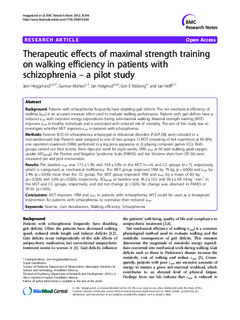| dc.description.abstract | Background: Patients with schizophrenia frequently have disabling gait deficits. The net mechanical efficiency of walking (Enet) is an accurate measure often used to evaluate walking performance. Patients with gait deficits have a reduced Enet with excessive energy expenditure during sub-maximal walking. Maximal strength training (MST) improves Enet in healthy individuals and is associated with reduced risk of mortality. The aim of this study was to investigate whether MST improves Enet in patients with schizophrenia.
Methods: Patients (ICD-10 schizophrenia, schizotypal or delusional disorders (F20-F29)) were included in a non-randomized trial. Patients were assigned to one of two groups: 1) MST consisting of 4x4 repetitions at 85-90% one repetition maximum (1RM) performed in a leg press apparatus or 2) playing computer games (CG). Both groups carried out their activity three days per week for eight weeks. 1RM, Enet at 60 watt walking, peak oxygen uptake (VO2peak), the Positive and Negative Syndrome Scale (PANSS) and the 36-items short form (SF-36) were measured pre and post intervention.
Results: The baseline Enet was 17.3 ± 1.2% and 19.4 ± 3.0% in the MST (n = 6) and CG groups (n = 7), respectively, which is categorized as mechanical inefficiency. The MST group improved 1RM by 79 kg (p = 0.006) and Enet by 3.4% (p = 0.046) more than the CG group. The MST group improved 1RM and Enet, by a mean of 83 kg (p = 0.028) and 3.4% (p = 0.028), respectively. VO2peak at baseline was 34.2 ± 10.2 and 38.3 ± 9.8 ml_kg-1_min-1 in the MST and CG groups, respectively, and did not change (p > 0.05). No change was observed in PANSS or SF-36 (p > 0.05).
Conclusions: MST improves 1RM and Enet in patients with schizophrenia. MST could be used as a therapeutic intervention for patients with schizophrenia to normalize their reduced Enet.
Keywords: Exercise, Gait disturbances, Walking efficiency, Schizophrenia | nb_NO |

